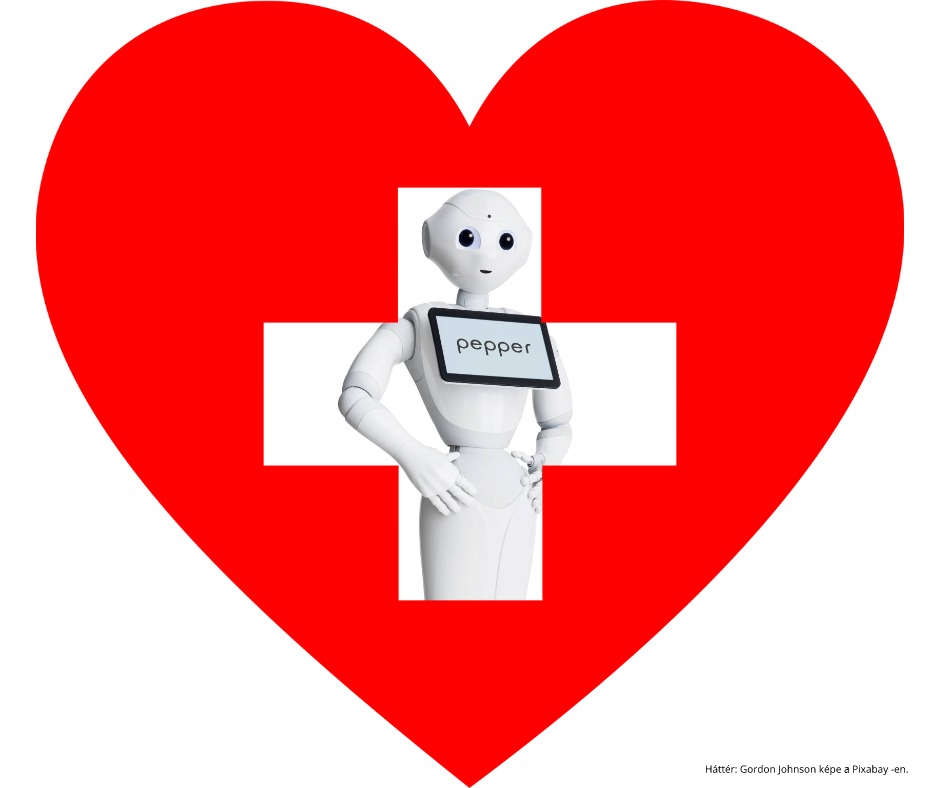Robot assistant in private health care
Get to know Pepper! In this post, you can read about the medical use of this humanoid robot. Therefore our aim is to provide robot assistant to hospitals, clinics, social institutions. As a result, it can reduce the pressure on staff and increase patient satisfaction.

Introduction of Pepper Robot
She is a 1.2 metre tall humanoid robot produced by Softbank Robotics. Our company is a Hungarian reseller and we also develop software solutions for the robot. In addition, we developed a voicebot, which allows you to speak Hungarian with Pepper. Therefore, “She” understand your voice, and responds autonomously using a pre-prepared knowledge base. Nevertheless, it doesn’t replace human staff, and it can help to reduce the pressure on hospital personnel and improve the quality of the service.
The advantages of a robot assistant
In addition, the robot is able to synthesize speech with the help of the knowledge base, which is created together with the client.
Its novelty lies in the voicebot we developed, it can communicate with the user through speech. This eliminates the use of chat bots or IVR systems that kill user experience.
This experience is fuelled by its humanoid design. Here you have to think mainly of the shape of the face, shoulders, hands and the torso. Also humanoid is the changing its posture or head position, gesturing with the help of built-in servo motors. It does everything according to the content of the conversation, e.g., it nods for yes, but shakes its head for no. This allows metacommunication, which makes the discussion much more understandable and dynamic. However, it doesn’t walk on legs, it can roll upon wheels.
Also, she is useful for marketing, it integrates into the image of the company, demonstrating the capability of innovation and development. It amazes the users, our partners simply call that an “aha” moment.
However, a particularly important feature in the health and social care sectors is that the ability of interpretating emotions.
Robotics and emotions?
Empathy and solidarity are essential elements of the hospital service. Could a robot do that?
In the case of Pepper, the answer is definitely yes. It is the world’s first “emotional” robot, because with her cameras and sensors so she can sense the reactions of a patient. In addition, it can also keep eye contact as it has a face recognition and face tracking function. These qualities, not to mention the humanoid design, allow emotional attachments.
As a result, robot assistants are now in use not only in clinics but also in retirement homes, making the work of nurses easier.
But how does the elderly people relate to robots?
Several studies on conversational robots have been published. Recently have the psychologists of Friedrich-Schiller University of Jena published a study in the magazine Computers in Human Behaviour. During the test, participants were divided into two groups. One included people who were in their 20’s, the other those who were in their 70’s.
During the test, participants were asked to rate the presented robots. The question was simple, how did they found the robots, more friendly or more scary? The results were surprising, those around the age of 70 were much more open to robots than 20-year-old generation. The experiment was led by Prof. Stefan Schweinberger.
Beyond Professor Schweinberger’s experiment, more and more researches are emerging about the human-robot interactions. The scientific world welcomed Pepper with great interest.
The MedicalOnline wrote recently about robot Pharos, which was developed at Spanish universities to attend elderly people. The article also mentions the developments of our company, as Pharos was modelled after Pepper. Click here to read (article of K. M. was published on medicalonline.hu, 05.11.2018.).
But in what kind of job can a hospital employ it?
Robot assistant at receptions
Seeing international examples, we can say that the boundaries of possibilities are only that of the imagination. We mainly develop for customer services and customer points. Above all, in clinics and retirement homes, this is supplemented by therapy sessions.
She is capable of recording data and performing administrative tasks, too. In other words, we can automate the answering of frequently asked routine questions. She is even much more efficient in this area than a human being. For instance, if the same question is asked a thousand times a day, the robot will answer it with the same enthusiasm. It does not freak out, get offended or tired.
Thanks to this, it welcomes patients with enthusiasm. It reassures a lot of people, if their problems doesn’t have to be shared with someone first. The robot makes a much more discrete impression on patients.
However, the goal is to help the overwhelmed nurses or doctors. Robots are useful helpers in everyday life, just like phones or computers.
We can list a pretty much foreign examples related to the hospital application of the robot.
- To begin with, Pepper is a 24/7 receptionist at the AZ Damiaan Hospital in Belgium. (Source: Medical Online)
- At the smart hospital in Wuhan the patients are treated by robots. (Source: CNet.com)
- In Canada, Humber River Hospital started to use Pepper robot. (Source: Hospital News)
To whom we recommend it?
However, the biggest business challenge nowadays is digital transformation. And this must be fullfiled in such a way that the new solutions also result in a greater user experience.
The non plus ultra of digital developements are voicebots using artificial intelligence. In addition, their use enables quick and simple communication with machines. So, you only need your voice for that.
With Pepper and voicebot we have developed a robot assistant that can achieve greater efficiency and competitive advantage, even for player in health sector. In addition, the robot can also be used for therapeutic purposes, that is shown by many international examples.
Therefore, this is a modern digital solution for private hospitals, clinics, retirement homes and many other social institutions.
